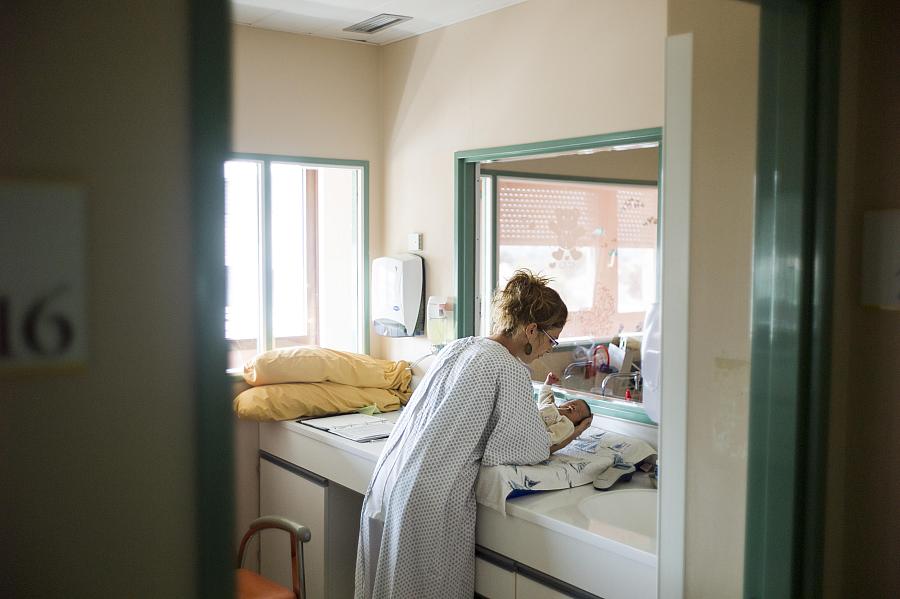For babies born addicted to opioids, the after-effects show up at school

Fred Dufour/Getty Images
One of the many heart-rending storylines to come out the opioid crisis in recent years has been the dramatic rise in the number of babies born with opioids in their system.
Nationally, the rate of neonatal abstinence syndrome (NAS) has risen from 2.8 births per 1,000 in 2008 to 7.3 per 1,000 in 2013, but the rise has been exponentially greater in rural areas such as Appalachia. The condition makes for an agonizing start to life, with newborns beset by shaking, diarrhea, fevers and ongoing high-pitched crying. Grueling as such an ordeal can be for the babies and their families, babies usually recover within six to eight weeks with the help of methadone or morphine.
That doesn’t mean there are no long-term risks that come with being born to an opioid-addicted mother. Reuters’ “Helpless and Hooked” investigation detailed the horrific things that can happen when babies are sent home to families still caught in the grips of addiction. But the fallout can take other forms, too. A new study of Australian children has found that children born with NAS performed significantly worse at school than their peers. The research suggests that the growing number of kids born with the condition in recent years will need extra support in school for decades to come to avoid falling behind their classmates.
For the study, researchers focused on children born between 2000 and 2006 in New South Wales. More than 2,200 kids with NAS were compared to 4,330 otherwise similar students on school test scores, with test results gathered from several grade levels over time. The research team found that children with NAS fell behind on test scores and that the gap widened as the students advanced.
At grade 3, children with NAS scored an average of 359 on the national test, while the control group scored 410 (both scores are lower than the 421 scored by same-age New South Wales students overall). “The deficit was progressive,” the researchers wrote. “By grade 7, children with NAS scored lower than other children in grade 5.”
Those kind of growing deficits are worrying, the researchers note:
This finding is of great concern because school failure increases the risk of myriad poor adult outcomes, including depression in women, criminal activity, and drug use. We showed that children with NAS performed more poorly in all five test domains, including reading or literacy skills, one of the most important predictors of school success.
The study can’t tell us why kids born with opioids in their system might be doing so much worse than their peers in school. It’s possible the drugs they absorbed — or the drugs used to ease withdrawals after birth — impaired normal brain development. But it’s also very plausible that children with NAS suffer academically because they’re born into families riven by addiction, poverty, missed school days and general neglect. Any one of those could readily qualify as an “adverse childhood experience.” When several of these stressful conditions are present, there’s a cumulative toll. It’ll be up to further studies to tease apart the pathways that lead children with NAS to fall behind in school so markedly.
(Interesting side note: The study found that children with NAS who were born to older mothers — over 30 — as well as mothers with relatively higher levels of education tended to do better in school.)
It’s also worth remembering this is just one study. Similar worries of long-term effects were voiced about “crack babies” during the epidemic’s height in the 1980s, but such fears haven’t been backed up by subsequent research.
But one of the themes of early childhood research over the past decade has been that early disadvantages beget disadvantages. It’s a pattern that’s repeated in the research on language, the research on stress and trauma and the research on poverty.
The same pattern holds true for the opioid crisis, which has disproportionately impacted poor, rural communities. Research published last year found that the rate of babies born with NAS in Kentucky’s Appalachia region was about 50 per 1,000, twice the state’s overall rate. In nearby West Virginia, one hospital reported a staggering rate of 139 out of 1,000 babies born with NAS in 2014, according to Reuters. (By comparison, the national average was six births per 1,000 in 2013, according to the CDC.)
Such numbers suggest that communities already struggling with poverty, unemployment and the opioid crisis are now bringing up a new generation of children liable to face serious challenges at school, and in turn, joblessness and chronic health problems. Left unaddressed, disparities have a relentless way of spilling over from one generation to the next.
**
Related posts
Opioid epidemic’s youngest victims are a growing group, new data show
Series highlights overlooked victims of opioid epidemic — babies

